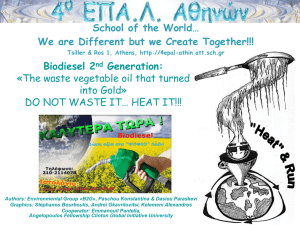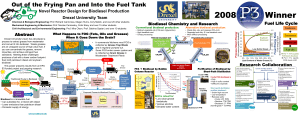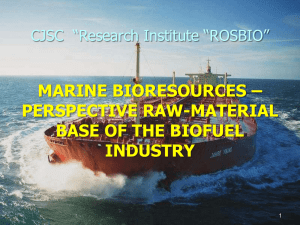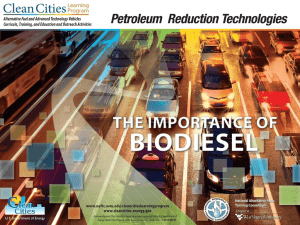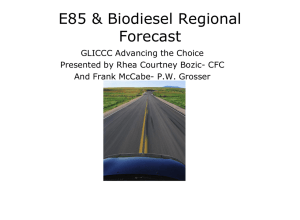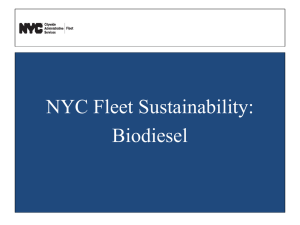PowerPoint Presentation - Biodiesel Lecture
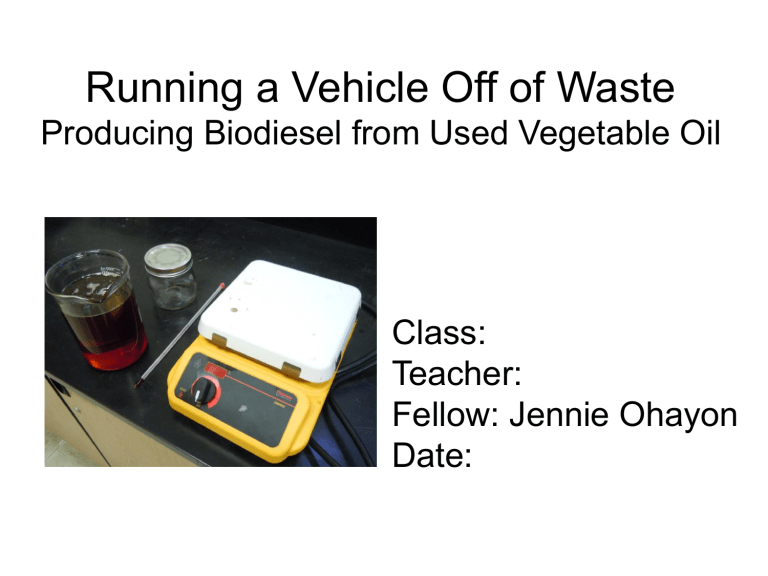
Running a Vehicle Off of Waste
Producing Biodiesel from Used Vegetable Oil
Class:
Teacher:
Fellow: Jennie Ohayon
Date:
Running a Bus on Vegetable Oil
•The stored energy in vegetable oil can power a vehicle
•A diesel engine will run on straight vegetable oil, but oil needs to be heated prior to use
•Biodiesel can be used in any diesel engine with no modifications to the vehicle.
•Due to difference in viscosity
Biodiesel Production
• Requires vegetable oil, an alcohol
(methanol) and a catalyst (KOH)
Glycerol 3 Fatty Acids
H
H
H
H
C
C
O
O
O
O
C
C
CH
2
CH
2
CH
2
CH
2
CH
3
CH
3
+ 3
H
3
C
Methanol
OH
Catalyst
(KOH)
O
O
3 H
3
C
C O
O
C CH
2
CH
2
CH
3
Biodiesel
H Trigylceride
Figure 2.
The reaction of a Triglyceride to Biodiesel and Glycerol
C
H
H C OH
CH
2
CH
2
CH
3
+ H
H
C OH
C
H
Glycerol
OH
Triglyceride
Biodiesel Production
Fatty Acid Chain
Glycerol
Catalyst (KOH)
Biodiesel
Methanol
Glycerol
Products of Reaction
• Biodiesel
• Glycerine
• Why do they separate?
• Because they separate, we can easily drain off the glycerine and be left with biodiesel!
Biodiesel
Glycerine
The Politics of Biofuels
• What might be some of the environmental and social benefits of biofuels?
• What might be some of the negative impacts of biofuels?
Producing Biodiesel from Waste Oil
• How does producing biodiesel from waste oil affect the environment?
• How does it affect the chemical reaction?
Free Fatty Acid
Free Fatty Acids Interfere
With Biodiesel Production
Soap
Methanol
Glycerol
Catalyst (KOH)
Methanol
Glycerol
Media Coverage of Schools
Producing Biodiesel
“ Galway students convert vegetable oil into biodiesel fuel.”
The Saratogian 15 January
2011
Making Biodiesel at
Watsonville High School!
The End… Ready to Make
Biodiesel?
Day 2; Teacher Notes for Introducing Part II of Lab
• If they did a great job the first part of lab, let them know; let them know if biodiesel and glycerine separated in their batches
• Recap what we did last week- What did we mix together?;
What are the products? What does the potassium hydroxide do?
• Read over introductory text from Part II of lab handout
• Show one of the group’s biodiesel; ask them which is the biodiesel layer and which is the glycerine
• The glycerine layer is on the bottom (discuss density)
• We will remove the glycerine today; we just want the biodiesel
(I will compost the glycerine as it biodegrades quickly)
Day 2; Teacher Notes for Introducing Part II of Lab
• Then we will wash it with water
• Much of the soap and glycerine produced, as well as any excess catalyst and alcohol, has settled out of the biodiesel layer
• However, even after 12 or 24 hours of settling there is still some left in the biodiesel fraction and this is why we wash it
• The water will remove impurities suspended in the biodiesel layer, including excess catalyst, soap, methanol and glycerine (they dissolve more readily in water than in biodiesel)
Day 2; Teacher Notes for Introducing Part II of Lab
• If the biodiesel reaction worked well, then when we wash it , the water should separate quickly from the biodiesel
(and then we can drain off the water, the same way we drained off the glycerine)
• We will wash the biodiesel at least five times; follow the procedure in your lab handout and make sure everyone gets the chance to wash it at least once
• If your biodiesel does not separate quickly into two layers or there is a thick white foamy layer in between the glycerine and biodiesel, then we would not want to use this biodiesel in our car (we need more practice with the biodiesel process)
Day 2; Teacher Notes for Introducing Part II of Lab
• If it does not separate quickly (see lecture notes from Day 1 for discussion on emulsion), then this is likely the result of either an incomplete reaction or too much soap
• Emulsifiers are used to make stable mixtures of water and oil
(like mayonnaise!)
• Recap free fatty acid discussion from first part (see lecture notes from Day 1)
• We added an excess of catalyst, because we know it will react with the degraded oil to produce soap and we want enough to be left over to catalyze the biodiesel reaction
(recap from first day)
• Too much soap being produced can lead to an emulsion when vigorously mixing the biodiesel and water together
• An incomplete reaction with poor conversion might have left us with half-processed monoglycerides and diglycerides; these are fuel contaminants that also act as emulsifiers.


![FOCI[3] - Clemson Sustainable Biofuels](http://s2.studylib.net/store/data/005791040_2-3405d51e06eba48ee2e076f677a28aa2-300x300.png)

